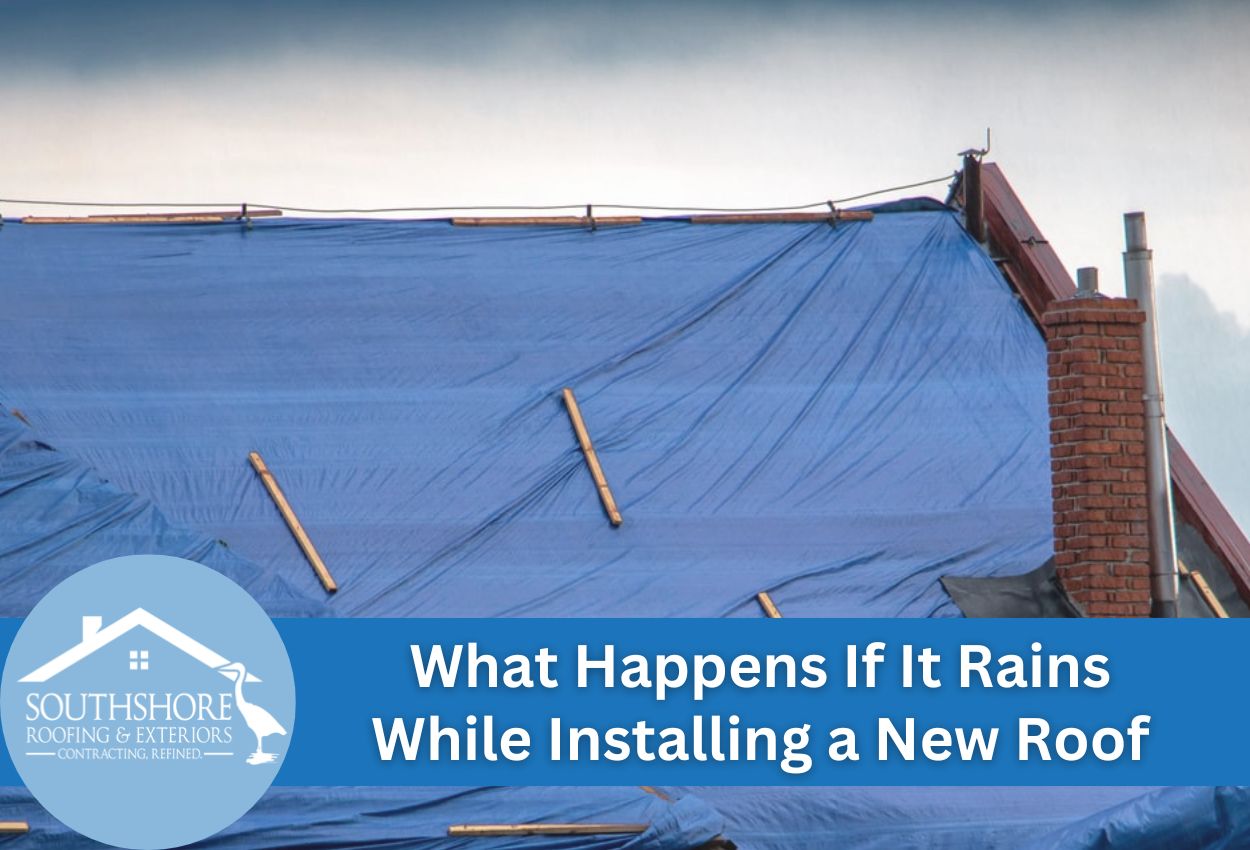When dark clouds gather during a roof replacement project, Tampa homeowners often wonder about the consequences of rainfall on their unfinished roof. Installing a new roof is a significant investment, and unexpected rain can introduce serious complications to the process. Professional roofing contractors typically monitor weather forecasts carefully before scheduling installation, but Florida’s unpredictable weather patterns sometimes bring surprise showers.
Rain during roof installation creates multiple risks that extend beyond simple delays. Water can penetrate exposed decking, seep into attic spaces, and compromise recently installed materials. For homeowners, this might mean potential structural damage to the roof framework, interior water damage, and the development of mold or mildew. Additionally, many roofing material manufacturers specify dry installation conditions in their warranty requirements.
Tampa’s subtropical climate means afternoon thunderstorms are common during the summer months. This makes proper planning and quick responses essential for local roofing projects. Knowing these risks can help homeowners understand why roofing contractors take weather-related precautions so seriously and may need to pause work during rain. Proper protection measures during unexpected rainfall can mean the difference between a successful roof installation and costly complications that could affect your home for years to come.
Weather Monitoring for Roofing Projects in Tampa
Florida’s climate requires Tampa roofing contractors to become amateur meteorologists when planning roof installations. The peninsula’s subtropical environment creates weather patterns that can change dramatically within hours, making careful monitoring essential before any roofing project begins. In Tampa specifically, the combination of Gulf and Atlantic influences means forecasting is especially challenging, as afternoon thunderstorms can develop with little warning.
Professional roofers in Tampa rely on sophisticated weather tracking tools beyond basic weather apps. Many contractors utilize professional-grade weather services that provide hour-by-hour precipitation probabilities, wind forecasts, and humidity levels, all factors that affect roofing installation success. Some Tampa roofing companies even use portable weather stations at job sites to track real-time conditions and anticipate sudden changes.
These approaches help contractors make decisions about project scheduling. For homeowners, this means fewer unexpected delays and reduced risk of rain damage during the roof replacement. The most reputable Tampa roofing companies have flexible schedules that allow quick adjustment when forecasts change to prioritize homes with exposed decking or partially completed sections.
Beyond daily forecasts, seasonal planning also plays a big role. While Florida has more workable roofing days than northern states, the summer rainy season (June through September) has other challenges that require additional precautions and contingency planning for successful roof installations.
Immediate Actions to Take When Rain Surprises Your Roofing Project
When unexpected rain interrupts your roof installation in Tampa, professional roofers must act quickly to protect both your home and the roofing materials. The first emergency protocol involves rapidly covering exposed roof areas with heavy-duty tarps or plastic sheeting, secured firmly to prevent wind from displacing them. These temporary coverings create a waterproof barrier that shields your home’s interior from potential water damage.
Experienced Tampa roofers will immediately prioritize protecting vulnerable entry points where water infiltration is most likely. This includes covering open roof decking, partially installed sections, and any areas where flashing hasn’t been completely secured. Materials that haven’t been installed will be gathered and covered or moved to a protected location to prevent water damage that could compromise their integrity.
Inside your home, a professional roofing team will position buckets or plastic sheeting under any potential leak points as a secondary defense against interior damage. They’ll also document the condition of the project before and after the rain event, which helps identify any issues that may require additional attention when work resumes.
Once the rain stops, the roofing contractors will thoroughly inspect all affected areas, removing standing water and allowing surfaces to completely dry before resuming installation. This drying period is critical, as installing new roofing materials over damp surfaces can lead to premature roof failure, mold development, and invalid warranties. These emergency response measures minimize the impact of unexpected rainfall and protect your roofing investment.
Potential Damage from Installing a Roof in Wet Conditions
Installing roofing materials during rainy weather can lead to serious long-term consequences for Tampa homeowners. When moisture becomes trapped beneath newly installed shingles, it creates perfect conditions for various forms of damage that typically don’t become evident until months or even years later. Florida’s naturally humid climate amplifies these risks, as trapped moisture may not evaporate even after the rain stops.
One of the biggest issues is compromised adhesion between shingles. Most asphalt shingles have self-sealing strips that require warm, dry conditions to properly bond. When installed wet, these strips often fail to create the watertight seal needed to withstand Florida’s intense storms. This compromised seal leaves your roof vulnerable to wind uplift during tropical storms and hurricanes that frequently threaten the Tampa area.
Additionally, moisture trapped beneath shingles can penetrate the roof deck, causing wood rot and structural weakening over time. This trapped moisture also creates perfect conditions for mold and mildew growth, which can spread to your attic and eventually affect indoor air quality. Roofing materials installed in wet conditions typically have a significantly shortened lifespan, sometimes failing in half the expected time.
Technical issues also arise when wet materials are installed. Underlayment may wrinkle or bubble, creating pathways for future water intrusion. Nail penetrations through wet materials don’t seal properly, leaving tiny openings that allow water to seep beneath the roof surface during subsequent rainstorms. These seemingly minor installation issues can lead to expensive repairs and even premature roof replacement.
Professional Methods to Protect Partially Installed Roofs
Tampa roofing professionals use specialized techniques to safeguard partially installed roofs when weather threatens. High-grade construction tarps, which are heavier and more durable than standard tarps, serve as the first line of defense. These professional-grade tarps feature reinforced edges with brass grommets spaced closely together, allowing secure anchoring that withstands Florida’s unpredictable wind gusts. These synthetic sheets are designed specifically for construction and conform more tightly to irregular surfaces than conventional tarps.
Correct tarping techniques are equally important. Professional roofers create overlapping layers that are secured not just at the edges but also at strategic middle points to prevent water pooling. They establish specific drainage channels within the tarp configuration to direct water away from vulnerable areas. Some Tampa roofing companies enhance protection by applying temporary water-resistant tape and adding weighted sandbags in patterns designed to maintain tarp tension even during sustained rainfall.
After rain subsides, these protective measures generally remain effective for 48 to 72 hours and Florida’s intense sun and humidity can degrade their effectiveness beyond this window. Professional roofers carefully assess moisture levels before resuming work, using moisture meters to check decking conditions. Work typically resumes when humidity readings drop below manufacturer-specified thresholds, which may require 24 to 48 hours of dry weather in Tampa’s climate. This careful approach maintains both roof integrity and warranty protection.
Impact on Project Timeline and Budget
Rain delays during roof installation inevitably affect both your project timeline and budget. In Tampa, where afternoon showers are common, homeowners should anticipate potential extensions to their roofing project schedule. Most roofing contractors build small weather contingencies into their timelines, but significant rainfall can extend a typical roof replacement by several additional days or even weeks during the rainy season.
These delays occur not just during actual rainfall but also during the drying periods afterward. Even a single heavy downpour can add 24 to 48 hours to your project timeline as contractors must wait for decking and underlayment to thoroughly dry before continuing. Consecutive days of rain can create cascading delays as crews may be rescheduled to other projects, further extending completion timelines.
From a budget perspective, rain during installation can introduce unexpected costs. While reputable Tampa roofing contractors won’t charge for standard weather delays, remediation costs for rain damage can impact your bottom line. These might include replacing water-damaged materials, additional labor for emergency tarping, or extra inspection fees to ensure structural integrity after water exposure. Some homeowners opt for upgraded temporary protection systems during particularly rainy periods, which are another potential cost increase.
Understanding these potential timeline extensions and budget impacts helps Tampa homeowners prepare realistically for their roofing projects. The best protection comes from working with experienced local contractors who understand our region’s challenging weather conditions.
Selecting a Roofer Prepared for Florida’s Weather Challenges
When investing in a new roof in Tampa, it’s important to choose a contractor with specific expertise in Florida’s challenging weather patterns. The frequent rain showers and sudden storms in the region require roofing professionals who’ve developed specialized protocols to protect your home during installation. Not all roofers are equally prepared for these conditions, making your contractor selection important for project success.
Start by asking potential roofers specific questions about their rain contingency plans. Qualified Tampa contractors should explain their weather monitoring systems, describe their tarping and protection protocols, and outline their procedures for securing partially completed work. Ask how they handle scheduling around forecasted rain and what specific measures they take to ensure materials stay dry throughout the installation process. Their answers will reveal their level of preparation and expertise.
Experience with Tampa’s specific climate conditions is non-negotiable during roofing projects. Local contractors who’ve spent years working through Florida’s rainy seasons have refined their approaches through trial and error. They understand the afternoon thunderstorm patterns, recognize the warning signs of approaching weather, and have developed time-tested strategies to protect in-progress installations. This knowledge helps minimize delays while ensuring your roof installation is completed to the highest standards.
Requesting references from previous customers who experienced weather delays during their projects can show how effectively a contractor manages these challenging situations. The best roofers combine technical expertise with weather management skills to deliver superior results regardless of the weather.
Expert Roof Installation in Tampa: Protecting Your Home from Florida’s Unexpected Rains
At SouthShore Roofing & Exteriors, we understand Florida’s climate and have developed proven protocols to protect your home when unexpected rain occurs during installation. Our experienced team monitors weather patterns, uses specialized tarping techniques, and installs moisture-resistant materials designed specifically for our humid conditions.
Don’t risk water damage, mold growth, or compromised warranty coverage with inexperienced contractors. Our certified professionals ensure your roof installation proceeds safely despite Tampa’s weather challenges. We provide detailed contingency plans, transparent timeline adjustments, and guaranteed protection for your home’s interior during the entire process.
Call SouthShore Roofing & Exteriors today at (813) 400-3329 to schedule your professional roof installation with Tampa’s roofing experts!




